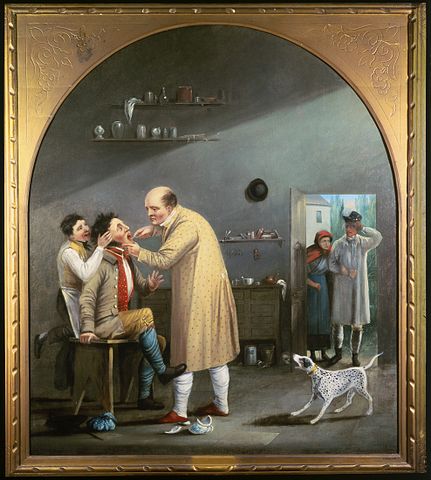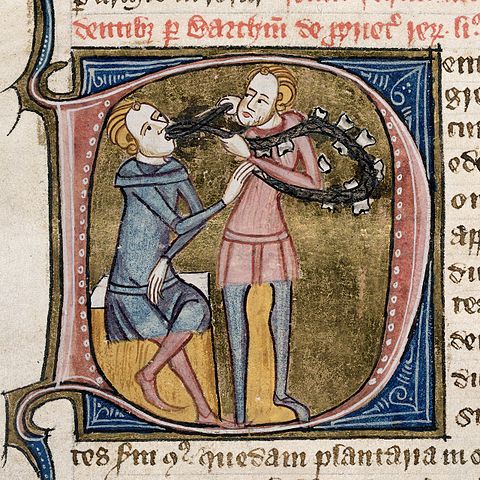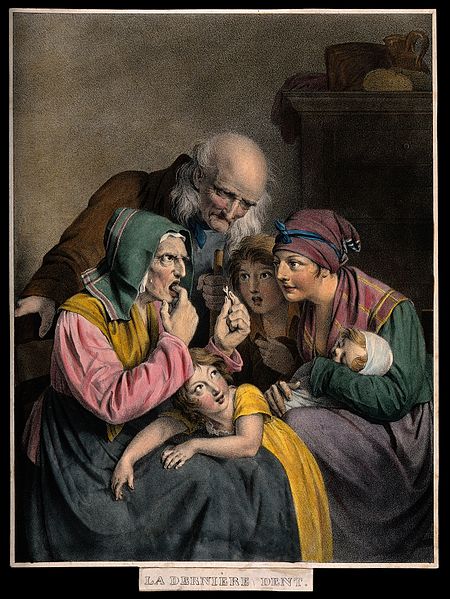
The Thammasat University Libraries have acquired two new books about teeth and dentistry: Teeth: a Very Short Introduction and The Excruciating History of Dentistry. Teeth: A Very Short Introduction is by Dr. Peter S. Ungar, a paleoanthropologist and evolutionary biologist who is professor of anthropology at the University of Arkansas. An expert on ecology as well as evolution, Dr. Ungar describes how teeth evolved over 500 million years. Over the years, teeth have become stronger and sharper, just as plants and animals became tougher to chew, to protect themselves. Animals eating different things have different kinds of teeth. To understand how humans evolved, Dr. Ungar spent many hours observing wild apes in rainforests of Latin America and Southeast Asia, studied fossils, and developed new ways of analyzing tooth shape and patterns of use from them. As Dr. Ungar’s laboratory website explains:
The focus of research in our laboratory is the ecology of past mammals, especially human ancestors. The laboratory employs and supports research of graduate students and undergraduates at the University of Arkansas and other universities, and fosters collaborations among researchers at many institutions across the US and abroad. Our current projects vary from reconstructing environments during human evolution in Africa to studying the extinction of giant marsupials at the end of the last ice age in Australia, and inferring the diets of our early ancestors and their kin. We use many approaches to studying tooth wear and shape as proxies for diet, including white-light confocal profilometry and laser scanning combined with scale-sensitive fractal analysis and geographic information systems software.
The Excruciating History of Dentistry is an informal, anecdotal account by the journalist James Wynbrandt. It includes information on how dentistry dates back at least 14,000 years. The oldest surviving dental filling is from around 6500 years ago, made of beeswax in Slovenia. 7000 years ago, Sumerians believed that dental cavities were caused by tooth worms, and this idea spread to India, Japan, and China. Even as late as the 1300s in France, some surgeons still believed that worms originated tooth decay. The word dentist has its origins in the Latin term dens or tooth. The French word dentiste became common in the 1700s, but in some English speaking countries, the word dentist seemed too fancy, and people who pulled out teeth in exchange for payment still preferred to be called tooth-drawers. Until the end of the 1800s, people were not just dentists, but also worked as barbers or doctors.

Dentistry in Thailand
An interesting article from 2007 on the education of dentists in Thailand was published in the International Dental Journal. Among its coauthors are Dr. Patcharawan Srisilapanan, Associate Professor at the Faculty of Dentistry of Chiang Mai University and Dr. Narumanas Korwanich, also of Chiang Mai University. The article notes that as of 2007:
There are eight public and one private dental school in Thailand. A six-year dental education leads to the DDS degree. On graduation from the public dental schools, dentists are required to work in the public system for three years. Currently, there are approximately 8,000 active dentists, with a dentist: population ratio of approximately 1:7,000.
In past years in Thailand, traditional medicines and herbs were used for taking care of toothache. Tooth decay was
regarded as an inevitable phenomenon that has to follow its natural course until the rotting tooth falls out by itself.
In 1940, the Kingdom’s first dental school opened as the Department of Oral Health, the Faculty of Medicine, Chulalongkorn University. In the 1980s, dental schools were operating in Bangkok, Chiang Mai, Khon Kaen, and Songkhla. These became highly important as medical studies showed a dramatic increase in tooth decay in Thai children. In 1984, almost one quarter of five- and six-year olds had no cavities in their baby teeth, By 2001, this figure had halved, so that almost 90 percent of Thai youngsters currently develop cavities in their teeth. Further studies in 2001 showed that even three year olds had severe tooth decay, with the problem being worst in rural communities. For older people too, keeping teeth in good condition directly relates to the ability to enjoy food, an important aspect of nutrition and maintaining good health. The Ministry of Public Health, the Thai Dental Council, and the Consortium of the Dental Schools actively collaborate to promote awareness of these issues. Among the faculties recognized by the Thai Dental Council is the doctoral program of the Faculty of Dentistry, Thammasat University, Rangsit campus. where students prepare their theses, do assignments, and study for exams at the Nongyao Chaiseri Library.

The article by Dr. Patcharawan, Dr. Narumanas, and others explains that in 2005, Thailand had 3,892 dentists in public service and 4,551 in private practice. 849 worked at universities and 218 with the military. Dental school curriculum in the Kingdom is
generally similar in the USA, Japan, Korea, and China. However, there is some uniqueness. For example, the Thai curriculum has more emphasis on dental public health including community and preventive dentistry. This is necessary to prepare students for the compulsory work they must undertake in a public hospital for three years after graduation.
The number of dentists has been steadily growing, from one dentists for every 22 people in 1990 to one dentist for every 7 people in 2005. Still, some areas are inadequately served. The authors conclude:
A point of difference between the Thai dental education system and overseas dental schools is the compulsory public services required of new graduates. This system has been in place since 1989, and has produced dentists to serve in the public hospitals, especially in the rural areas, for over 17 years. In addition, the government has developed special incentives to supplement the fixed salary to encourage and maintain the dentists in the public sectors. This strategy has been very successful in retaining some dentists to work in the rural areas.
It is to be hoped that international exchange with dental programs overseas will continue to benefit Thai dentistry and help people in the Kingdom enjoy better dental health. Meanwhile, international exchange occurs in the familiar form of dental tourism, people who arrive from Australia, New Zealand, and other countries for dental procedures done at lower cost than at home.
Academic exchanges are also increasing, such as in 2014, when the University of Washington School of Dentistry signed an new agreement with the Chulalongkorn University Faculty of Dentistry. The goals are to increase faculty exchange and research collaboration.

(All images courtesy of Wikimedia Commons)
